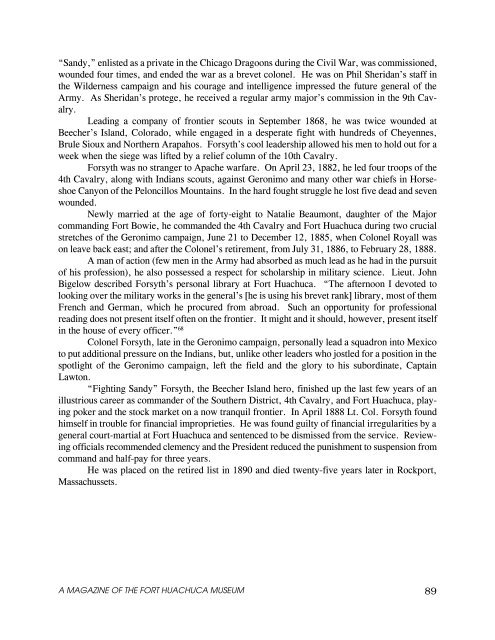Apache Campaigns - Fort Huachuca - U.S. Army
Apache Campaigns - Fort Huachuca - U.S. Army
Apache Campaigns - Fort Huachuca - U.S. Army
You also want an ePaper? Increase the reach of your titles
YUMPU automatically turns print PDFs into web optimized ePapers that Google loves.
“Sandy,” enlisted as a private in the Chicago Dragoons during the Civil War, was commissioned,<br />
wounded four times, and ended the war as a brevet colonel. He was on Phil Sheridan’s staff in<br />
the Wilderness campaign and his courage and intelligence impressed the future general of the<br />
<strong>Army</strong>. As Sheridan’s protege, he received a regular army major’s commission in the 9th Cavalry.<br />
Leading a company of frontier scouts in September 1868, he was twice wounded at<br />
Beecher’s Island, Colorado, while engaged in a desperate fight with hundreds of Cheyennes,<br />
Brule Sioux and Northern Arapahos. Forsyth’s cool leadership allowed his men to hold out for a<br />
week when the siege was lifted by a relief column of the 10th Cavalry.<br />
Forsyth was no stranger to <strong>Apache</strong> warfare. On April 23, 1882, he led four troops of the<br />
4th Cavalry, along with Indians scouts, against Geronimo and many other war chiefs in Horseshoe<br />
Canyon of the Peloncillos Mountains. In the hard fought struggle he lost five dead and seven<br />
wounded.<br />
Newly married at the age of forty-eight to Natalie Beaumont, daughter of the Major<br />
commanding <strong>Fort</strong> Bowie, he commanded the 4th Cavalry and <strong>Fort</strong> <strong>Huachuca</strong> during two crucial<br />
stretches of the Geronimo campaign, June 21 to December 12, 1885, when Colonel Royall was<br />
on leave back east; and after the Colonel’s retirement, from July 31, 1886, to February 28, 1888.<br />
A man of action (few men in the <strong>Army</strong> had absorbed as much lead as he had in the pursuit<br />
of his profession), he also possessed a respect for scholarship in military science. Lieut. John<br />
Bigelow described Forsyth’s personal library at <strong>Fort</strong> <strong>Huachuca</strong>. “The afternoon I devoted to<br />
looking over the military works in the general’s [he is using his brevet rank] library, most of them<br />
French and German, which he procured from abroad. Such an opportunity for professional<br />
reading does not present itself often on the frontier. It might and it should, however, present itself<br />
in the house of every officer.” 68<br />
Colonel Forsyth, late in the Geronimo campaign, personally lead a squadron into Mexico<br />
to put additional pressure on the Indians, but, unlike other leaders who jostled for a position in the<br />
spotlight of the Geronimo campaign, left the field and the glory to his subordinate, Captain<br />
Lawton.<br />
“Fighting Sandy” Forsyth, the Beecher Island hero, finished up the last few years of an<br />
illustrious career as commander of the Southern District, 4th Cavalry, and <strong>Fort</strong> <strong>Huachuca</strong>, playing<br />
poker and the stock market on a now tranquil frontier. In April 1888 Lt. Col. Forsyth found<br />
himself in trouble for financial improprieties. He was found guilty of financial irregularities by a<br />
general court-martial at <strong>Fort</strong> <strong>Huachuca</strong> and sentenced to be dismissed from the service. Reviewing<br />
officials recommended clemency and the President reduced the punishment to suspension from<br />
command and half-pay for three years.<br />
He was placed on the retired list in 1890 and died twenty-five years later in Rockport,<br />
Massachussets.<br />
A MAGAZINE OF THE FORT HUACHUCA MUSEUM<br />
89

















